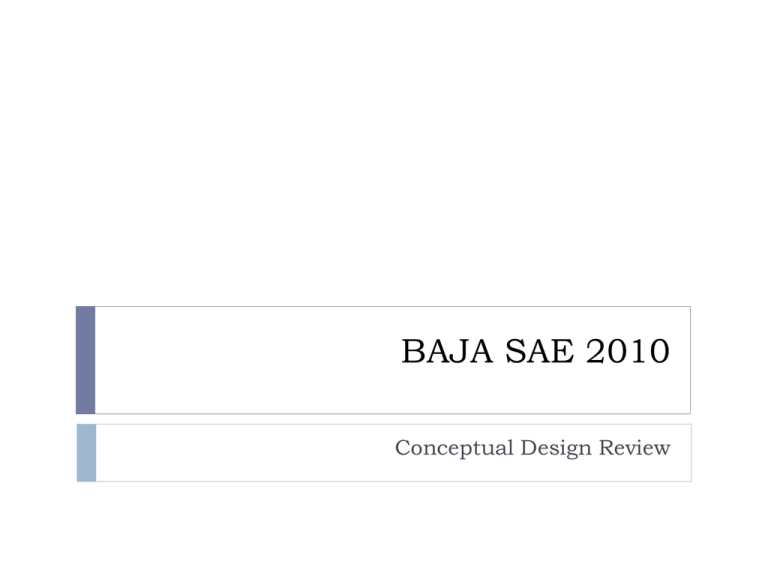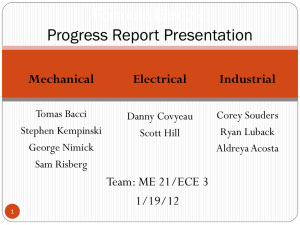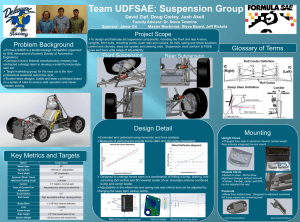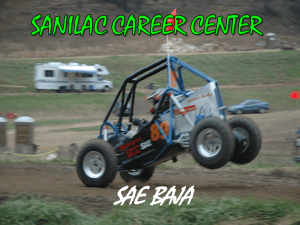Mini Baja 2010 - Hurricane Motor Works
advertisement

BAJA SAE 2010 Conceptual Design Review Statement of Work Baja SAE is an international collegiate design competition sponsored by the Society of Automotive Engineers. The program simulates real-world engineering design projects and the related challenges with the goal of developing and building a small offroad vehicle. Teams from around the world compete in static and dynamic events to have their design accepted for manufacture by a fictitious firm. Team Responsibilities Sam Moran – Chief Executive Officer; Frame Designer; Welder/Grinder Michael Guilfoy – Steering Engineer; Chief Financial Officer; Welder/Machinist Sam Weitkemper – Drivetrain Engineer; Executive Secretary Ben McNealy – Braking Engineer; Analyst; Director of Internet Services Matt Wantland – Analyst; Materials Acquisition Specialist; Fabricator Dan Pickering – Suspension Engineer; Chief Mechanic Ahmed Al-Gattan – Chief Safety Officer Customers SAE Competition Fictitious Firm Sponsors Safe vehicle Maneuverability, Traction, Suspension, Acceleration Design/Manufacturability Cost Competitive vehicle Promotion Faculty Advisors Competition success Educational experience Benchmarking Vehicle Engineering Specifications Front Track Width Rear Track Width Wheelbase Weight Suspension Drivetrain Data from 2009 Baja SAE Alabama competition Benchmarking Number of Teams Using a Specific Wheelbase 8 7 Number of Teams 2010 TU car 6 5 4 2009 TU car 3 2 1 0 42 44 46 48 50 52 54 56 58 60 62 64 66 68 70 72 74 76 78 80 82 84 86 Wheelbase (in.) Benchmarking Number of Teams Using a Specific Front Track Width 16 14 Number of Teams 12 10 8 6 2010 TU car 4 2 2009 TU car 0 48 49 50 51 52 53 54 55 56 57 58 59 Front Track Width (in.) 60 61 62 63 64 65 Benchmarking Number of Teams Using a Specific Rear Track Width 16 14 Number of Teams 12 2010 TU car 10 8 6 2009 TU car 4 2 0 49 50 51 52 53 54 55 56 57 58 Rear Track Width (in.) 59 60 61 62 63 64 Benchmarking Analysis of top 11 overall performing cars from 2009 Baja SAE Alabama competition Specification Value Wheelbase (in.) 62.2 Front Track Width (in.) 57.6 Rear Track Width (in.) 54.9 Weight (lbs.) 396.3 Frame Concept 1 – The Nose Box Advantages: simple few packaging constraints Disadvantages: inefficient use of space Frame Concept 2 – Integrated Cockpit Advantages: more legroom efficient use of space light Disadvantages: Complicated design Frame Concept 3 – “The Cage” Advantages: simple design requires the least amount of planning allows for last-stage drivetrain changes Disadvantages: heavy difficult drivetrain maintenance Frame Concept 4 – Double Loop Advantages: lightweight efficient easy drivetrain maintenance Disadvantages: difficult to design not conducive to double aarm suspension stuck with drivetrain choices Frame Concept & Design Front Rear Length designed for the reach of the team’s smallest driver Clearance designed for the 95th percentile male Integrated cockpit design Double loop design inspired by Queen’s University Frame members do not interfere with removal of drivetrain components Weight: 73 lbs Length: 80.5” Width: 31.0” Height: 52.9” Final Frame Design Frame Material Given in 1018 PCS 2 different specifications Strength/Stiffness Critical Components – Roll Cage Non-Critical Components – frontal/side impact Sizing Calculations Roll Cage Requirements mm Inches 1018 Steel Outer Diameter 25 0.984 Density (g/c3) 7.87 Wall Thickness 3 0.1181 E-Modulus (Gpa) 205 Sultimate (Mpa) 440 Syield (Mpa) 365 I (mm4) 12777.64 c (mm) 12.5 Bending Strength Bending Stiffness M = Syield*I/c Stiffness = E*I Min---> Max Moment (N-m) 373.11 Min---> Max Moment (lb-ft) 274.96 Min---> Stiffness (N-m2) 2619.42 Tubing Possibilities Tubing Size (in) Minimum 0.75 X .080 1.00 X 0.095 1.25 X 0.095 1.28 X 0.071 1.00 X 0.060 Source X Tenaris Tenaris Tenaris QuikService QuikService Yield (Mpa) X 480 620 550 365 365 Strength (N-m) Stiffness (N-m2) Weight (lbs/ft) 375 2620 X 225 817 0.57 627 2385 0.91 903 4937 1.17 462.1 4218.7 0.91 235 1676 0.6 Hi Performance – Expensive/Light Economical – Cheap/Heavy Compromise – In between Frame Specifications Lengths of Different Tubing Large Req. Tubing (ft) 25 Small Req. Tubing (ft) 68 Non Required (ft) Option 1 - Economical 2 - Hi-Performance 3 - Compromise 0 Cost $0.00 $650.00* $40.00 Final Tubing Sizes Lrg OD (in) 1.28 Lrg t (in) 0.071 Sm OD (in) 1 Sm t (in) 0.06 *http://www.airpartsinc.com/products/4130-steel-tubing.htm Frame Wt. (lbs) 92 44.2 63.8 Drivetrain Benchmarking Team Oregon State South Florida Sherbrooke Cornell Maryland SUNY Buffalo Rochester Tech SUNY Stony Brook Transmission CVT w/ transaxle 6-speed gearbox CVT w/ chain drive Differential driver-lockable open solid rear axle limited slip CVT not specified CVT w/ transaxle CVT CVT w/ transaxle auto-locking not specified auto-locking CVT w/ transaxle limited slip Drivetrain Concept #1 CVT with chain drive Pros: lightweight, simple, cheap Cons: no reverse gear, requires tensioning system Drivetrain Concept #2 Motorcycle gearbox with chain drive Pros: easy to find, includes reverse gear Cons: more difficult for the driver Drivetrain Concept Chosen CVTech CVT with Dana H-12 transaxle Pros: Simple, proven reliability, F/N/R, auto-locking differential Cons: Heavy Drivetrain Layout 2010 Axle Design Drivetrain Specifications Max Ratio Min Ratio Top Speed Max Gradient Max Engine Power Max Engine Torque Idle Max RPM Weight Tire Diameter 39.75 (35.60) 5.70 (6.98) 34 mph (35 mph) 52 % (70%) 9.1 HP 13.8 ft-lbs 1750 3800 120 lbs 22” Front Suspension Double A-arm configuration The front suspension system for a majority of the cars at last year’s competition Benefits The length and orientation of the arms can be designed for the vehicle’s application. Computers can be used to design the suspension geometry Front Suspension The vehicle was designed around the suspension mounting points To prevent conflicts between the suspension and other vehicle components Mechanism synthesis was performed in SolidWorks with the help of Dr. Daily Front Suspension Mounting points Geometric constraint analysis was performed to determine the suspension mounting points for a given tie rod length and designed for no bump steer Constraints: 5 degrees of camber and 10 inches of vertical travel for a 52-inch front track width Top arm length: 16.375” Bottom arm length: 16.50” Front Suspension Roll center The front roll center was determined using SolidWorks For the desired mounting points, the roll center was found to be about 3.05 inches above the ground Rear Suspension Solid Rear Axle/ Swing Arm Top finishers such as Queen’s University and Michigan University used a swing arm with a solid rear axle. Double A-arm A majority of the cars at last year’s Mini Baja used a double wishbone configuration. More appropriate for cars without a solid rear axle Simple After discussing options with the team, a double wishbone configuration was chosen Rear Suspension Mounting points Geometric constraint analysis was again performed to determine the suspension mounting points Constraints: no camber change and 8 inches of vertical travel for a 50-inch rear track width Top arm length: 16.50” Bottom arm length: 16.50” Rear Suspension Roll center The rear roll center was determined using SolidWorks given parallel equal length arms For the desired mounting points, the roll center was found to be at the ground Shocks and Springs The shock mounting points were set by the frame design and restrained by the control arm movement. The ideal shock travel for the given wheel travel was determined from mechanism synthesis. Steering Concepts Power Steering Additional components Requires power Complicated integration inside steering box Four-Wheel Steering Challenging integration Untested in competition conditions Steering Concepts Rack and Pinion Steering Simplified system Light Ease of integration with suspension Used by nearly every Baja SAE team Ackerman Geometry 51” 62.5” Modeling Steering Angles 27.73° Outside Wheel Lock Position 45.49° Inside Wheel Lock Position Turning Radius Results Turning Radius Composition 12 Turning Radius (ft) 10 8 6 4 2 0 Track Width Wheelbase Track Width (in) 52.00 Wheelbase (in) 60.00 Steering Angle (deg) 36.61 Turning Radius (ft) 10.55 Steering Specifications Chosen Concept: Rack and Pinion 14 inch length; 4.5 inches of travel 1.5 turns lock-to-lock Turning radius of approximately 10.5 feet Ackerman Geometry Tie Rod Connection Rack mounting to minimize lateral loads Rack mounting considered in frame design Front Suspension design clearance issues addressed Braking Concepts Rules require two independent hydraulic systems Disc brakes Light Compact Used by nearly all Baja teams Drum brakes Heavy Bulky Braking Concepts Single cylinder, dammed reservoir Pros: simple, packaging flexibility Cons: longer than dual cylinders Dual cylinders, overhead mount Pros: shortest overall length Cons: aesthetics Dual cylinders, floor mount Pros: elegant packaging Cons: longer, may conflict with steering components Braking Concepts Rigid lines Pros: Rigid, look good Cons: Difficult to install Braided flex lines Pros: Flexible, easier to install Cons: Heavier Braking Concept Selected Polaris discs and calipers Dual US Brake master cylinders Wilwood reverse mount pedal Braided steel flex line Safety Braking Drivetrain Two independent hydraulic braking systems Capable of locking the wheels No plastic brake lines CVT cover – made of polymer Gas catch – made of polymer Kill Switches Two kill switches required One in cockpit, one in rear Safety Frame pads The minimum required thickness is ½”. The cost is $17.95 per 3 feet. Need 6 feet. Safety helmet Motor cross style, Snell M2005 specification Safety Fire extinguisher Two 5 B-C extinguishers. One must be mounted next to the driver and the other in the pit area. Head restraint Goals and Deadlines January 25 – complete design February 28 – drivable vehicle rolls under its own power basic safety gear March 28 – competition-ready vehicle stress analysis CAD models meets all rules fully functional, painted, polished, done. April 8-11 – 2010 Baja SAE Carolina competition Schedule Budget Retail Cost Customer Cost Vehicle System Costs Frame Tubing - Donated $ 750.00 $ - Tubing - Purchased $ 350.00 $ 100.00 $ 1,100.00 $ 100.00 Transaxle $ 1,320.00 $ - Engine $ 450.00 $ 450.00 CVT $ 130.00 $ 130.00 Rear Drive Axles $ 1,000.00 $ 1,000.00 Miscellaneous $ 885.00 $ 680.00 $ 3,785.00 $ 2,260.00 Shocks $ 1,160.00 $ 1,160.00 A-Arms $ 250.00 $ 250.00 Wheel Uprights $ 768.29 $ 374.00 $ 2,178.29 $ 1,784.00 Rack and Pinion $ 98.00 $ 98.00 Accessories $ 247.00 $ 247.00 $ 345.00 $ 345.00 Braking $ 1,124.09 $ 433.00 Tires and Maintenance $ 396.00 $ 160.00 Miscellaneous $ 500.00 $ 500.00 $ 9,428.38 $ 5,582.00 System Total Competition Expenses Travel to South Carolina Hotel $ 1,000.00 $ - Transportation and More $ 1,000.00 $ 1,000.00 $ 2,000.00 $ 1,000.00 $ 1,000.00 $ 1,000.00 $ 3,000.00 $ 2,000.00 Driving/Safety Gear $ 800.00 $ 400.00 Team Uniforms $ 300.00 $ 300.00 Office Supplies $ 100.00 $ 100.00 Fabrication Tools $ 250.00 $ 250.00 $ 1,450.00 $ 1,050.00 Total Engineering $ 97,500.00 $ - Total Fabrication $ 43,350.00 $ - Total Testing $ 10,500.00 $ - $ 151,350.00 $ - TOTAL Drivetrain System Total Suspension System Total Steering System Total TOTAL VEHICLE EXPENSES Customer Cost Retail Cost Entry Fee TOTAL COMPETITION EXPENSES Team Operation Expenses TOTAL OPERATION EXPENSES Team Labor Expenses TOTAL LABOR EXPENSES Retail Cost Total Anticipated Costs $ 165,228.38 Customer Cost $ 8,632.00 Budget Retail Cost Competition Expenses Customer Cost $ 3,000.00 $ 2,000.00 Frame $ 1,100.00 $ 100.00 Drivetrain $ 3,785.00 $ 2,260.00 Suspension $ 2,178.29 $ 1,784.00 Steering $ 345.00 $ 345.00 Braking $ 1,124.09 $ 433.00 Tires and Maintenance $ 396.00 $ 160.00 Miscellaneous $ 500.00 $ 500.00 $ 9,428.38 $ 5,582.00 Team Operation Expenses $ 1,450.00 $ 1,050.00 Team Labor Expenses $ 151,350.00 $ - Vehicle System Costs TOTAL VEHICLE EXPENSES Total Anticipated Costs $ 165,228.38 $ 8,632.00 Budget Hourly Rate Extended Cost Item Description Engineering Design & Analysis $75.00 $0.00 1300 $97,500.00 $0.00 Fabrication Machining Time $50.00 $0.00 30 $1,500.00 $0.00 Welding Fixtures $45.00 $0.00 12 $540.00 $0.00 Tube Bending $45.00 $0.00 6 $270.00 $0.00 Welding $45.00 $0.00 72 $3,240.00 $0.00 Assembly $45.00 $0.00 840 $37,800.00 $0.00 Testing & Analysis $75.00 $0.00 140 $10,500.00 $0.00 2400 $151,350.00 $0.00 Testing Total Labor Costs Retail Rate Customer Rate Quantity Retail Cost Customer Cost





